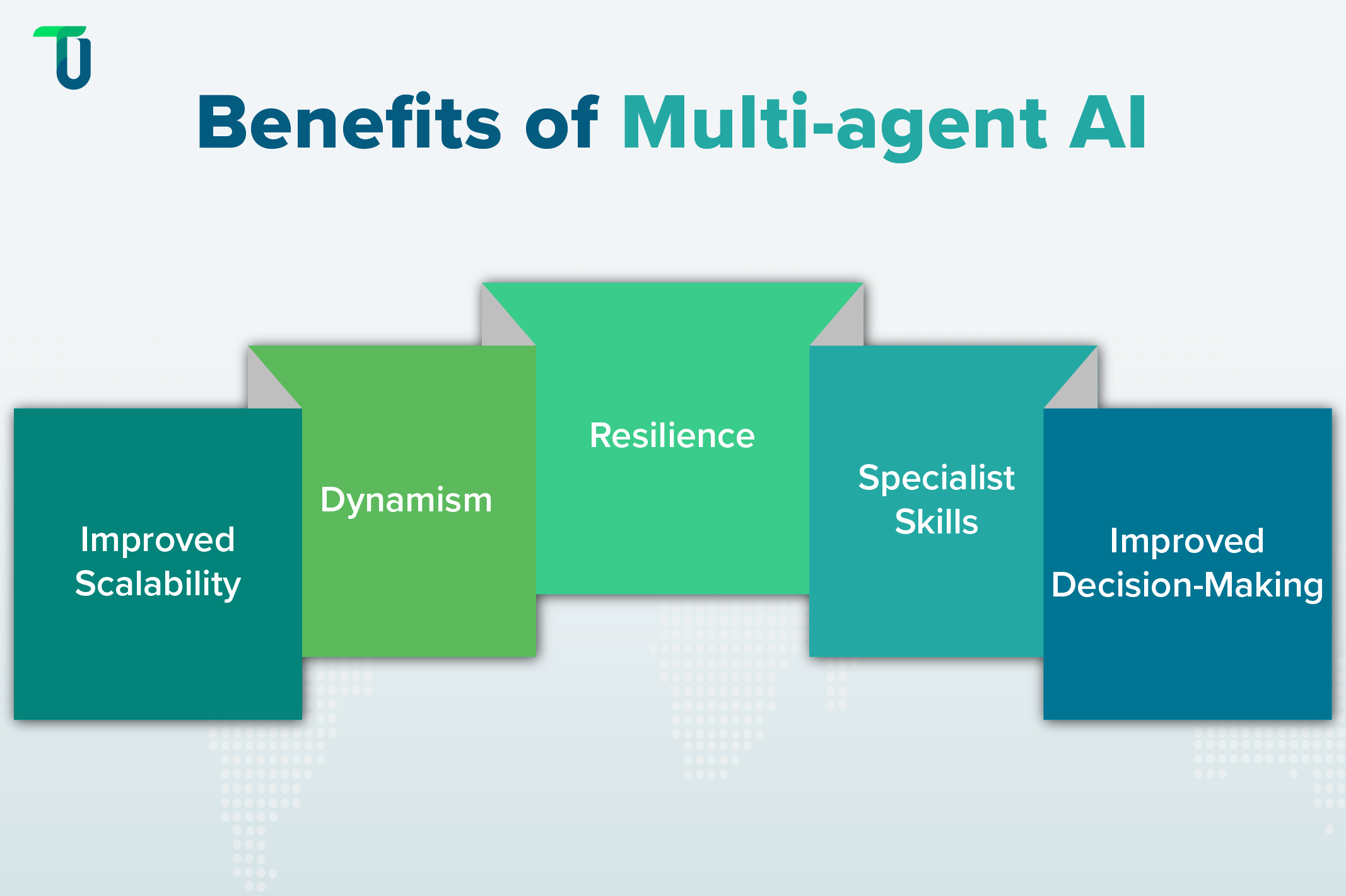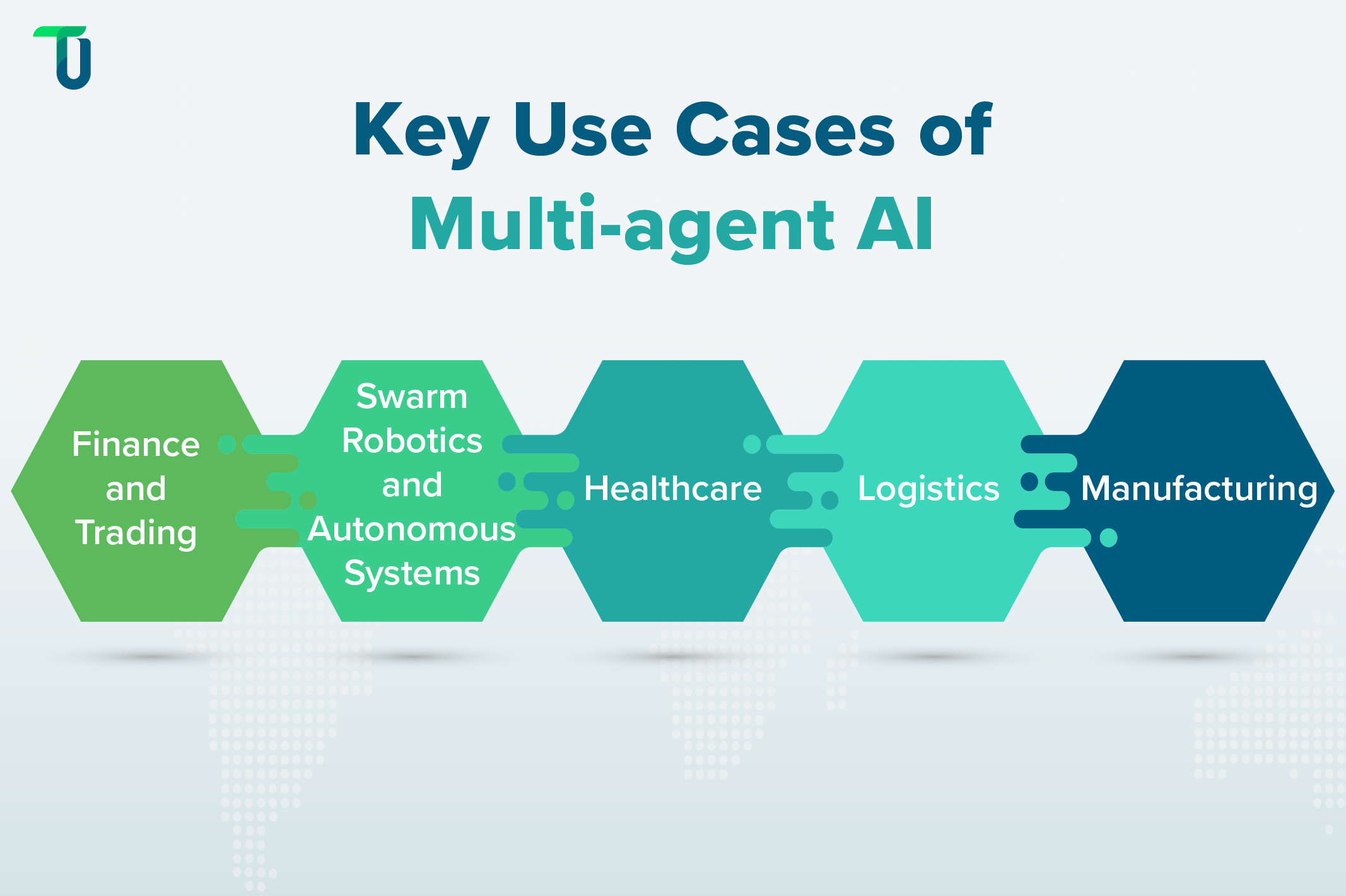Why the Need for Multi-Agent AI: Addressing the Limitations of Single-Agent AI
First, let’s look at single-agent AI. One single entity is responsible for executing tasks and automation independently in single-agent AI. Single-agent systems have centralized control, making decisions based on internal algorithms and data that is fed. This approach is ideal when the problems are simple and clearly defined. However, they are not well-suited for scenarios that need decision-making, adaptability, collaboration, or scale.
Limitations of Single-Agent AI
Single-agent AI has been successful in applications that use personal assistants like Siri or Alexa, or for basic automation tasks. However, the limitations appear when complexity is introduced.
Limited Problem-Solving Skills: A single agent does not possess the know-how to divide tasks or collaborate with other entities, restricting the ability to handle layered or dynamic problems.
Prone to Failures: The entire system may break down if a single agent encounters an error or fails due to a lack of a backup mechanism.
Poor Scalability: With increasing task complexity, single-agent systems struggle to manage their workload well.
Rigid Framework: Single-Agent AI can be inflexible and finds it challenging to adapt to new tasks or environments.
Narrow Focus: Single-Agent systems are specialized and may struggle within areas that need diverse expertise.
Enter a More Advanced Solution: Multi-agent AI
Multi-agent AI leverages the power of multiple, independent agents that work together to achieve shared goals. These agents can not only communicate with each other, but also delegate tasks based on specialization and change their approach to respond to changes in their environment. This is what makes multi-agent systems perfect for solving complex problems requiring coordination and scalability.
Multi-agent System (MAS) comprises multiple AI agents like LLM agents and other task-specific agents that collaborate on varied tasks on behalf of users or systems. These systems are valuable in fulfilling large-scale, complex tasks that encompass hundreds or more agents.
How Multi-Agent AI Overcomes the Limitations of Single-Agent AI
Multi-agent systems resolve many of the challenges faced by single-agent systems with the following benefits:

Improved Scalability: Multi-agent AI scales effortlessly by adding more agents to the system when needed. Each agent has specific areas of expertise, enabling the system to take on larger workloads without compromising efficiency. For example, in a logistics and supply chain management application, LLM agents can handle inventory tracking, and other task-specific agents can optimize delivery routes and manage warehouse operations simultaneously.
Dynamism: Single-agent systems struggle with unpredictability. However, multi-agent AI thrives in dynamic scenarios where complexity and real-time dynamism demand more intelligence and collaboration. Agents can share information in real time and tweak their strategies accordingly. Moreover, multi-agent AI also helps optimize resource usage by adjusting operations based on current system states and workloads. For instance, traffic management systems use Multi-agent systems to adapt traffic signals based on current traffic levels and reroute vehicles dynamically.
Resilience: To a large extent, multi-agent systems are decentralized and resilient to failures. If one agent fails, another takes over or compensates, ensuring the system remains operational. Multi-agent systems are ideal for critical use cases where continuity is important. For example, in disaster management operations where autonomous robots collaborate to find survivors even if one agent malfunctions.
Specialist Skills: A multi-agent system often comprises individual agents that have expertise in specific functions while fulfilling common goals. This specialization helps with problem-solving across multiple domains. For instance, in automated financial trading systems, different AI agents can specialize in specific tasks like trend analysis, arbitrage, and risk management to optimize trading strategies, using specialized expertise for enhanced decisions.
Improved Decision-Making: By combining knowledge from multiple agents, multi-agent systems can make more informed decisions compared to a single agent acting alone. This allows for improved collaboration, flexibility, and parallel problem-solving. The instantaneous sharing of information among agents improves situational awareness, speeding up decision-making. For example, multi-agent systems can optimize energy distribution in a smart power grid based on real-time demand, supply fluctuations, and grid stability.
Why Multi-Agent Systems Outperform Single-Agent Systems
Unlike centralized AI systems, MAS avoids depending on a single decision point for resolution. Moreover, MAS uses emergent solutions, such as communication between agents to find innovative answers that are not possible with isolated AI. For example, finding novel energy distribution patterns in power grids. Multi-agent systems also build their reliability profiles over a period of time, prioritizing inputs from high-performing peers.
Ready to Scale with Multi-Agent AI?
Whether it’s improving decision-making, enhancing automation, or enabling intelligent collaboration, multi-agent AI is the future.
Implementation and Real-World Use Cases of Multi-Agent AI
Multi-agent systems are highly versatile, making them suitable for a wide range of applications across industries. Here are some important applications:

Finance and Trading: Multi-agent systems can execute trades based on market signals, reducing latency and improving the bottom line. Moreover, they can analyze the transactions from various perspectives to check for anomalies and potential fraud.
Swarm Robotics and Autonomous Systems: Drones and robots can work in rescue operations, warehouse automation, or space exploration. Multi-agent systems also have great potential in autonomous vehicles and factory automation, leading to optimized routes, smarter manufacturing and assembly lines.
Healthcare: Multi-agent systems work toward patient care coordination, allowing providers to share information securely and collaborate on treatment plans. They are also helpful in precision medicine, where specialized agents can aid in diagnosis, treatment plans, and customized medicine approaches.
Logistics: AI-based planning and bidding can streamline production, storage, and shipping. Multi-agent systems ensure effective inventory management with predictive analysis. Multiple AI agents can monitor and optimize the movement of goods in real time, reducing delays and costs.
Manufacturing: Multi-agent systems can control machines, inventory, logistics, and assembly automation to streamline manufacturing flows. Industries are already leveraging AI agents to monitor equipment, predict potential failures, and allow for proactive maintenance and reduced disruption. Collaborative robotics are used to complete complex and dynamic tasks autonomously.
Check out our blog discussing the critical role of Agentic AI in customer experience management.
Single-Agent AI vs Multi-Agent AI: Which One Is Appropriate For You?
Both single-agent AI and multi-agent AI are used effectively for specific challenges and scenarios.
If your business needs require the automation of simple tasks with centralized control, then single-agent AI might be useful for you. If your industry or application is highly dynamic, needing independent coordination and decision-making, then multi-agent AI will offer scalability, adaptability and data-backed decision-making.
Artificial General Intelligence and the Future of Multi-agent Systems
The use of Artificial General Intelligence(AGI) is increasingly linked to advances in multi-agent AI. Here, intelligent agents collaborate, adapt and learn continuously from one another to gain human-like reasoning. Using cross-agent communication, shared learning, and emergent decision-making, researchers are uncovering new possibilities in AI capabilities. There is a greater focus on decentralized learning, where agents evolve as a group without a central controller. Another emerging trend is neuro-symbolic AI, which blends machine learning with logic-based reasoning. With recent innovations in self-improving AI and reinforcement learning, multi-agent systems are used in more autonomous and flexible AGI applications such as healthcare, logistics, military, and more.
Leverage the Power of Multi-agent AI to Resolve Complex Issues
With the rapid evolution of technology stacks across industries, embracing multi-agent AI systems will be important for resolving complex problems that need coordination and flexibility. By using the power of collaboration among smart agents, multi-agent AI unlocks new avenues for innovation for each sector. Check out our case study where we utilized multiple AI agents to automate a complex purchase order processing workflow involving two teams and several IT systems. By integrating a multi-agent system into their existing IT infrastructure, we enabled our client to derive tangible benefits
Our team of AI experts, at TenUp, is adept at building customized solutions that align with our clients' business problems and requirements. You could explore our comprehensive AI development services to learn more about our AI capabilities and understand how we can work together to build scalable AI solutions to support your business growth.
Unlock the Full Potential of Multi-Agent AI
From optimizing logistics to revolutionizing healthcare and manufacturing, multi-agent AI is reshaping industries. Don’t let single-agent limitations hold you back.
Frequently asked questions
What is the difference between single-agent and multi-agent AI systems?
Single-agent AI systems operate independently to accomplish tasks, whereas multi-agent AI systems consist of multiple autonomous agents that collaborate or compete within an environment to achieve objectives.
What are the main advantages of implementing multi-agent AI systems?
Multi-agent AI systems offer improved scalability, flexibility, and robustness. They excel in handling complex tasks through distributed problem-solving, enhance fault tolerance by mitigating single points of failure, and adapt effectively to dynamic environments.
What challenges are associated with developing multi-agent AI systems?
Challenges include ensuring effective communication and coordination among agents, managing the complexity of interactions, and maintaining system stability. Addressing these requires robust design and testing methodologies.
Are there established frameworks for building multi-agent AI applications?
Yes, several frameworks exist, such as Agno, OpenAI Swarm, LangGraph, Microsoft Autogen, and CrewAI. These provide tools and libraries to facilitate the development and deployment of multi-agent systems.
How do multi-agent systems handle conflicts between agents?
Conflict resolution strategies may include predefined protocols, negotiation mechanisms, or hierarchical control structures to ensure agents work collaboratively towards common goals.
Can multi-agent AI systems learn and adapt over time?
Yes, through techniques like reinforcement learning, multi-agent systems can adapt their behaviors based on experiences, improving performance and responsiveness to environmental changes.
What is swarm intelligence, and how does it relate to multi-agent AI?
Swarm intelligence refers to the collective behavior of decentralized systems, often observed in nature. In AI, it inspires algorithms where simple agents follow local rules, leading to the emergence of complex, coordinated behaviors.

